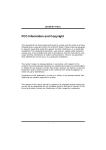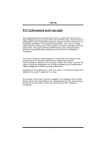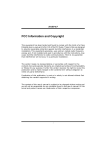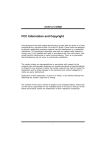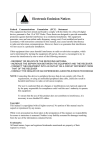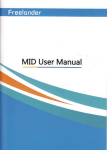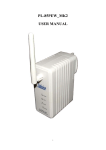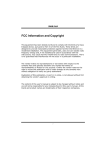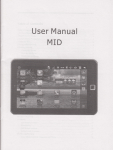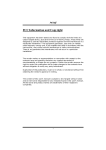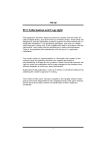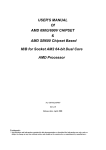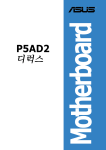Download Biostar P4TGP 775 Owner's Manual
Transcript
P4TGP7 75 FCC Information and Copyright This equipment has been tested and found to comply with the limits of a Class B digital device, purs uant to Part 15 of the FCC Rules . These limits are designed to provide reas onable protection against harmful interference in a residential installation. T his equipment generates , uses and c an radiate radio frequency energy and, if not installed and used in accordance with the instructions , may c ause harmful interference to radio c ommunications . There is no guarantee that interference will not occur in a particular installation. The vendor makes no representations or warranties with respec t to the contents here and specially disclaims any implied warranties of merchantability or fitness for any purpos e. Further the vendor reserves the right to revis e this publication and to make c hanges to the contents here without obligation to notify any party beforehand. D uplication of this public ation, in part or in whole, is not allowed without first obtaining the vendor’s approval in writing. The content of this user’s manual is subject to be c hanged without notice and we will not be respons ible for any mistakes found in this user’s manual. All the brand and produc t names are trademarks of their respec tive companies . 1 P4TGP7 75 TABLE OF CONTENTS Chapter 1: Introduction..........................................3 1.1 P4TPG775 Features ...............................................3 1.2 Package Checklist..................................................5 1.3 Layout of P4TGP775..............................................6 1.4 Components of P4TGP775 ....................................7 Chapter 2: Hardware Installation ...........................8 2.1 Central Processin Unit (CPU) ...............................8 2.2 Memory Modules Installation.............................10 2.3 Connectors and Slots...........................................11 2.4 Headers and Jumpers..........................................12 2.5 Award BIOS beep code.......................................17 2.6 Troubleshooting ..................................................17 Chapter 3: WarpSpeeder™..............................18 3.1 Introduction.........................................................18 3.2 System Requirement ...........................................18 3.3 Installation...........................................................19 2 P4TGP7 75 CHAPTER 1: INTRODUCTION 1.1 P4TPG775 FEATURES A. Hardware CPU Supports single Pentium 4 processor with the 1-MB L2 cache and Celeron D with the 2k6K L2 chace in the 90 nm processe s in an LGA 775 package. Intel Platform Compatibility Guide 04B Front side bus at the following frequency ranges: 533 MT/s (133 MHz core Clock) 800 MT/s (200 MHz Core Clock) Supports Hyper-Threading Technology. Chipset North Bridge: Intel 915P. South Bridge: Intel ICH6R. Main Memory Supports DDR-333/400 Supports256-Mb, 512-Mb, 1G-Mb DDR technologies for x8 and x16 non-ECC DDR devices. Maximum DRAM address decode space of 4GB (assuming 32-bit addressing.) Support for non-ECC memory only. Registered DIMMs not supported. Supe r I/O Chip: ITE IT8712. Low Pin Count Interface. Provides the most commonly used legacy Super I/O functionality. Environment Control initiatives, - H/W Monitor - Fan Speed Controller - ITE's "Smart Guardian" function Slots 3 32-bit PCI bus master slots. 3 PCI-EXPRESSx1 slots. - Bandwidth 250MB/s per direction; 500MB/s Totally - PCI Express supports a raw bit-rate of 2.5Gb/s on the data pins. - 2X bandwidth over the traditional PCI architecture. 1 PCI-ESPRESSx16 slot. - Maximum theoretical realized bandwidth of 4GB/s simultaneously per direction, for an aggregate of 8GB/s totally. 3 P4TGP7 75 SLR slot: - BIOSTAR Home Gate Way Slot used with BIOSTAR SOHO Router Card On Board IDE Supports 1 IDE disk drives. Supports PIO Mode 5, Bride Mode and Ultra DMA 33/66/100 Bus Master Mode. IDE RAID Chip Chip: ITE8212 Supports 4 IDE disk drives. - Integrated RAID 0, RAID 1 and RAID 0+1 for RAID1/RAID2 slot. Supports PIO Mode 5, Bride Mode and Ultra DMA 33/66/100 Bus Master Mode. Se rial ATA Supports 4 Serial ATA (SATA) ports. - Intel Advanced Host Controller (AHCI). - Integrated RAID 0,RAID 1, and RAID 0+1 capabilities. Compliant with SATA 1.0 specification Data transfer rates up to 1.5 Gb/s LAN Chip: RTL8100C (optional)/8110S Gigabit LAN Chip Supports 10 Mb/s, 100 Mb/s and 1Gb/s auto-negotiation. (1Gb/s can be only supported with RTL8110S chipset.) Half/Full duplex capability. Supports ACPI power management IEEE 1394A Chip Chip: VIA VT6307. Support 2 ports with transfer up to 400Mb/s. On Board High De finition Audio Sound Code c Chip: CMI9880/ALC880E Compliant with High Definition Audio specification.. Supports 8 channels Audio Output - SNR > 95dB meet the consumer entertainment industry formats. - 192KHz with 24bits - 8 channel Smart Jack - Dolby Digital Interactive Content Encoder (Dolby DDICE) On Board Pe riphe rals a. Rear side 1 1 1 2 parallel port. (SPP/EPP/ECP mode) RJ-45 LAN jack (optional). 1394A Firewire port serial ports. 4 P4TGP7 75 4 USB2.0 ports. Audio ports in vertical position. Supports PS/2 mouse and PS/2 keyboard. b. Front Side 1 floppy port supports 2 FDDs with 360K, 720K, 1.2M, 1.44M and 2.88Mbytes. 1 front audio header. 1 S/PDIF header. 1 1394A Firewire port. 4 USB2.0 ports. Dimensions ATX Form Factor: 24.5 x 29.3cm (W x L) B. BIOS & Software BIOS Award legal BIOS. Supports APM1.2. Supports ACPI. Supports USB Function. Software Supports Warpspeeder™, 9th Touch™, WINFLASHER™ and FLASHER™. Offers the highest performance for Windows 98 SE, Windows 2000, Windows Me, Windows XP, SCO UNIX etc. 1.2 PACKAGE CHECKLIST FDD Cable X 1 HDD Cable X 1 User’s Manual X 1 Fully Setup Driver CD X 1 Rear I/O Panel for ATX Case X 1 USB 2.0 Cable X1 (optional) S/PDIF Cable X 1 (optional) Serial ATA Cable X 1 (optional) IEEE 1394 Cable X 1 (optional) Serial ATA Power Switch Cable X 1 (optional) 5 P4TGP7 75 1.3 LAYOUT OF P4TGP775 Note: st 1. ● represents the 1 pin. 2. One of the BIOS is optional. 6 P4TGP7 75 1.4 COMPONENTS OF P4TGP775 A. JATXPWR1: ATX Power Connector B. JATXPWR2: ATX Power Connector C. JUSBV1: Power Source Selection for USB D. JKBV1: Power Source Selection f or Key board/Mouse E. Back Panel Connectors F JAUDIOF1: Front Audio Header G. PCI-EX16: PCI Express slot. H. JCDIN1: CD-ROM Audio-In Header I. JSPDIF_OUT1/JSPDIF_IN1: Digital Audio Connector J. PCI-EX1_1~3: PCI Express slot. K. 1394PWR1: Selection 1394 Power Header L. PCI1~3: Peripheral Component Interconnect Slots M. U20: LAN card/Router card slot. N. JDJ1: Audio DJ Header O. JUSB3: Front USB Header P. JUSB4: Front USB Header Q. JUSBV3_1: Power Source Selection f or USB R. J1394A1: Front 1394 Header S. T. U. V. W. JSFAN1: System Fan Header JPANEL1: Front Panel Connector RAID1~2: Raid Connectors JCMOS1: Clear CMOS Header SATA1~4: Serial ATA Connectors X. JCL1: Case Open Header Y. IDE1: Hard Disk Connectors Z. FDD1: Floppy Disk Connector A1. DDRA1-2/DDRB1-2: DDR DIMM Modules A2. JCFAN1: CPU Fan Connector 7 P4TGP7 75 CHAPTER 2: HARDWARE INSTALLATION 2.1 CENTRAL PROCESSIN UNIT (CPU) Special Notice: Remove Pin Cap before installation, and make good preservation for future use. When the CPU is removed, cover the Pin Cap on the empty socket to ensure pin legs won’t be damaged. Pin Cap Step 1: Pull the lever sideways away from the socket and then raise the lever up to a 90-degree angle. Step 2: Look for the black cut edge on socket, and the white dot on CPU should point wards this black cut edge. The CPU will fit only in the correct orientation. Step 2-1: 8 P4TGP7 75 Step 2-2: Step 3: Hold the CPU down firmly, and then close the lever to complete the installation. Step 4: Put the CPU Fan on the CPU and buckle it. Connect the CPU FAN power cable to the JCFAN1. This completes the installation. CPU FAN He ade r: JCFAN1 Pin 1 2 3 4 1 JCFAN1 Assignment Ground Power FAN RPM rate sense Smart Fan Control System Fan Heade r: JSFAN1 1 Pin 1 2 JSFAN1 3 Assignment Ground Smart Fan Control FAN RPM rate sense Note: The JCFAN1 and JSFAN1support system cooling f an with Smart Fan Control utility. It supports 3 pin head connector. When connecting with wires onto connectors, please note that the red wire is the positive and should be connected to pin#2, and the black wire is Ground and should be connected to GND. 9 P4TGP7 75 2.2 MEMORY MODULES INSTALLATION 1. Unlock a DIMM slot by pressing the retaining clips outward. Align a DIMM on the slot such that the notch on the DIMM matches the break on the Slot. 2. Insert the DIMM vertically and firmly into the slot until the retaining chip snap back in place and the DIMM is properly seated. Note: To assure the system safety, if you need to change DDR modules, firstly, please unplug the 12-pin power cable with the power connector, and then you can change the modules. Afterwards, plug in the cable the power connector again, and finally you can boot up the system. 10 P4TGP7 75 2.3 CONNECTORS AND SLOTS Floppy Disk Connector: FDD1 The motherboard provides a standard floppy disk connector that supports 360K, 720K, 1.2M, 1.44M and 2.88M floppy disk types. This connector supports the provided floppy drive ribbon cables. Hard Disk Connectors: IDE1 The motherboard has a 32-bit Enhanced PCI IDE Controller that provides PIO Mode 0~5, Bus Master, and Ultra DMA 33/ 66/ 100 functionality. It has two HDD connectors IDE1 (primary) and IDE2 (secondary). The IDE connectors can connect a master and a slave drive, so you can connect up to four hard disk drives. The first hard drive should always be connected to IDE1. Peripheral Component Interconnect Slots: PCI 1~3 This motherboard is equipped with 5 standard PCI slots. PCI stands for Peripheral Component Interconnect, and it is a bus standard for expansion cards. This PCI slot is designated as 32 bits. Serial ATA Connector: SATA1~4 The motherboard has a PCI to SATA Controller with 2 channels SATA interface, it satisfies the SATA 1.0 spec and with transfer rate of 1.5Gb/s. 65 3 2 7 4 1 S ATA1/S ATA2 S ATA3/S ATA4 Pin 1 3 5 7 Assignment Ground TXRXGround 11 Pin 2 4 6 Assignment TX+ Ground RX+ P4TGP7 75 2.4 HEADERS AND JUMPERS 2.4.1 How to setup Jumpers The illustration shows how to set up jumpers. When the jumper cap is placed on pins, the jumper is “close”, if not, that means the jumper is “open”. Pin opened 2.4.2 Pin closed Pin1-2 closed Detail Settings Powe r Conne ctors: JATXPWR1/JATXPWR2 JATXPWR1: This connector allows user to connect 20-pin power connector on the ATX power supply. JATXPWR2: By connecting this connector, it will provide +12V to CPU power circuit. 12 24 1 13 JATXPWR1 1 3 2 JATXPWR2 Pin 1 2 3 4 5 6 7 8 9 10 11 12 Assignment +3.3V +3.3V Ground +5V Ground +5V Ground PW_OK Standby Voltage +5V +12V +12V 2 x 12 Detect Pin Assignment 1 +12V 2 +12v 12 Pin 13 14 15 16 17 18 19 20 21 22 23 24 Assignment +3.3V -12V Ground PS_ON Ground Ground Ground -5V +5V +5V +5V Ground Pin Assignment 3 Ground 4 Ground P4TGP7 75 Powe r Source Sele ction for Keyboard/Mouse: JKBV1 JKBV1 3 Assignment Description 1 +5V +5V f or key board and mouse +5V Standby Voltage PS/2 mouse and PS/2 keyboard are powered with +5V standby v oltage. Pin 1-2 close 3 1 Pin 2-3 close Note: In order to support this function “Power-on system via keyboard and mouse”, “JKBV1” jumper cap should be placed on Pin 2-3. Powe r Source Sele ction for USB: JUSBV1/JUSBV3_1 JUSBV1/ JUSBV3_1 1 3 Pin 1-2 close Assignment +5V +5V standby 1 3 Pin 2-3 close Voltage Description JUSBV1: +5V for USB at the JUSB1 connector port. JUSBV3_1: +5V for USB at the JUSB 2/3 connector ports. JUSBV1: JUSB1 port powered with standby voltage of 5V JUSBV3_1: JUSB2/3 ports powered with standby v oltage of 5V Note: In order to support this function “Power-o system via USB device,” “JUSBV1/ JUSBV3_1” jumper cap should be placed on Pin 2-3 individually. Front Panel Audio Heade r: JAUDIO F1 This header allows user to connect the front audio out put cable with the PC front panel. It will disable the output on back panel audio connectors. 2 1 Pin 1 3 5 7 9 11 13 14 13 Assignment Pin Mic in/center 2 Mic power/Bass 4 Right line out/Speaker out 6 Right Reserv ed 8 Lef t line out/Speaker out 10 Lef t Right line in/Rear speaker 12 Right Lef t line in/Rear speaker 14 Lef t 13 JAUDIOF1 Assignment Ground Audio power Right line out/Speaker out Right Key Lef t line out/Speaker out Lef t Right line in/Rear speaker Right Lef t line in/Rear speaker Lef t P4TGP7 75 CD-RO M Audio-in Heade r: JCDIN1 This connector allows user to connect the audio source from the veriaty devices, like CD-ROM, DVD-ROM, PCI sound card, PCI TV turner card etc.. Pin 1 2 3 4 1 JCDIN1 Assignment Lef t channel input Ground Ground Right channel input Digital Audio Connector: JSPDIF_O UT1 This connector allows user to connect the PCI bracket SPDIF output header. 1 Pin Assignment 1 2 3 JSPDIF_OUT1 +5V SPDIF_OUT Ground Digital Audio Connector: JSPDIF_IN1 This connector allows user to connect the PCI bracket SPDIF input header. 1 Pin Assignment 1 2 3 JSPDIF_IN1 +5V SPDIF_IN Ground AUDIO DJ Conne ctor: JDJ1 5 Pin 1 3 5 1 JDJ1 Assignment SMBDATA INT_B AXT_PWROK Pin 2 4 Assignment SMBCLK Key Powe r Source for 1394: J1394PWR1 J1394PWR1 1 3 Pin 1-2 close 1 3 Pin 2-3 close Assignment Description +3.3V SB +3.3V SB for 1394 chipset. +3.3V +3.3V f or 1394 chipset. (Def ault) Front 1394 Heade r: J1394A1 2 1 10 9 J1394A1 Pin 1 3 5 7 9 Assignment A+ Ground B+ +12v Key 14 Pin 2 4 6 8 10 Assignment AGround B+12V Ground P4TGP7 75 Front USB He ade r: JUSB3/4 This header allows user to connect additional USB cable on the PC front panel, and also can be connected with internal USB devices, like USB card reader. 2 1 10 9 JUSB3/4 Pin Assignment 1 +5V (f used) 3 USB5 USB+ 7 Ground 9 Key Pin 2 4 6 8 10 Assignment +5V (f used) USBUSB+ Ground NC Front Panel Conne ctor: JPANEL1 This 24-pin connector includes Power-on, Reset, HDD LED, Power LED, Sleep button, speaker and IrDA Connection. It allows user to connect the PC case’s front panel switch functions. SLP PWR_LED ON/ OFF 2 24 1 23 S PK Pin 1 3 5 7 9 11 13 15 17 19 21 23 IR HLED Assignment +5V N/A N/A Speaker HDD LED (+) HEE LED (-) Ground Reset control N/A N/A +5V IRTX R ST IR Function Pin 2 Speaker 4 Connector 6 8 10 Hard driv e LED 12 14 Reset button 16 18 20 IrDA Connector 22 24 Assignment Sleep control Ground N/A Power LED (+) Power LED (+) Power LED (-) Power button Ground Key Key Ground IRRX JPANEL1 Function Sleep button N/A Power LED Power-on button IrDA Connector Close CMOS Heade r: JCMOS1 By placing the jumper on pin2-3, it allows user to restore the BIOS safe setting and the CMOS data, please carefully follow the procedures to avoid damaging the motherboard. JCMOS1 1 3 1 3 Assignment Pin 1-2 close Pin 2-3 close 15 Normal Operation (Def ault). Clear CMOS data. P4TGP7 75 ※ Clear CMOS Proce dures: 1. 2. 3. 4. 5. 6. Remove AC power line. Set the jumper to “Pin 2-3 close”. Wait for five seconds. Set the jumper to “Pin 1-2 close”. Power on the AC. Reset your desired password or clear the CMOS data. Case O pen He ade r: JCL1 This connector allows system to monitor PC case open status. If the signal has been triggered, it will record to the CMOS and show the message on next boot-up. 1 2 JCL1 Pin 1 2 Assignment Case open signal Ground Back Panel Conne ctors 16 P4TGP7 75 2.5 AWARD BIOS BEEP CODE Beep Meaning One long beep followed by two short Video card not f ound or video card beeps memory bad High-low siren sound 1. CPU overheated 2. System will shut down automatically One Short beep when system No error found during POST boot-up Long beeps ev ery other second No DRAM detected or install 2.6 TROUBLESHOOTING Probable No power to the system at all Power light don’t illuminate, f an inside power supply does not turn on. 2. Indicator light on key board does not turn on. System inoperativ e. Keyboard lights are on, power indicator lights are lit, and hard driv e is spinning. System does not boot from hard disk driv e, can be booted f rom CD-ROM driv e. 1. 1. 2. 3. Solution Make sure power cable is securely plugged in. Replace cable. Contact technical support. Using even pressure on both ends of the DIMM, press down firmly until the module snaps into place. 1. Check cable running from disk to disk controller board. Make sure both ends are securely plugged in; check the driv e type in the standard CMOS setup. 2. Backing up the hard drive is extremely important. All hard disks are capable of breaking down at any time. System only boots from CD-ROM. 1. Back up data and applications f iles. Hard disk can be read and applications can be used but booting 2. Ref ormat the hard driv e. from hard disk is impossible. Re-install applications and data using backup disks. Screen message says “Invalid Rev iew system’s equipment. Make Conf iguration” or “CMOS Failure.” sure correct inf ormation is in setup. Cannot boot system after installing 1. Set master/slave jumpers second hard driv e. correctly. 2. Run SETUP program and select correct driv e types. Call the drive manuf acturers f or compatibility with other drives. 17 P4TGP7 75 CHAPTER 3: WARPSPEEDER™ 3.1 INTRODUCTION [WarpSpeeder™], a new powerful control utility, features three user-friendly functions including Overclock Manager, Overvoltage Manager, and Hardware Monitor. With the Overclock Manager, users can easily adjust the frequency they prefer or they can get the best CPU performance with just one click. The Overvoltage Manager, on the other hand, helps to power up CPU core voltage and Memory voltage. The cool Hardware Monitor smartly indicates the temperatures, voltage and CPU fan speed as well as the chipset information. Also, in the About panel, you can get detail descriptions about BIOS model and chipsets. In addition, the frequency status of CPU, memory, AGP and PCI along with the CPU speed are synchronically shown on our main panel. Moreover, to protect users' computer systems if the setting is not appropriate when testing and results in system fail or hang, [WarpSpeeder™] technology assures the system stability by automatically rebooting the computer and then restart to a speed that is either the original system speed or a suitable one. 3.2 SYSTEM REQUIREMENT OS Support: Windows 98 SE, Windows Me, Windows 2000, Windows XP DirectX: DirectX 8.1 or above. (The Windows XP operating system includes DirectX 8.1. If you use Windows XP, you do not need to install DirectX 8.1.) 18 P4TGP7 75 3.3 INSTALLATION 1. Execute the setup execution file, and then the following dialog will pop up. Please click “Next” button and follow the default procedure to install. 2. When you see the following dialog in setup procedure, it means setup is completed. If the “Launch the WarpSpeeder Tray Utility” checkbox is checked, the Tray Icon utility and [WarpSpeeder™] utility will be automatically and immediately launched after you click “Finish” button. 19 P4TGP7 75 Usage: The following figures are just only for reference, the screen printed in this user manual will change according to your motherboard on hand. [WarpSpeeder™] includes 1 tray icon and 5 panels: 1. Tray Icon: Whenever the Tray Icon utility is launched, it will display a little tray icon on the right side of Windows Taskbar. This utility is responsible for conveniently invoking [WarpSpeeder™] Utility. You can use the mouse by clicking the left button in order to invoke [WarpSpeeder™] directly from the little tray icon or you can right-click the little tray icon to pop up a popup menu as following figure. The “Launch Utility” item in the popup menu has the same function as mouse left-click on tray icon and “Exit” item will close Tray Icon utility if selected. 2. Main Panel If you click the tray icon, [WarpSpeeder™] utility will be invoked. Please refer to the following figure; the utility’s first window you will see is Main Panel. Main Panel contains fe ature s as follows: a. b. c. Display the CPU Speed, CPU external clock, Memory clock, AGP clock, and PCI clock information. Contains About, Voltage, Overclock, and Hardware Monitor Buttons for invoking respective panels. With a user-friendly Status Animation, it can represent 3 overclock percentage stages: Man walking→overclock percentage from 100% ~ 110 % Panther running→overclock percentage from 110% ~ 120% Car racing→overclock percentage from 120% ~ above 20 P4TGP7 75 3. Voltage Panel Click the Voltage button in Main Panel, the button will be highlighted and the Voltage Panel will slide out to up as the following figure. In this panel, you can decide to increase CPU core voltage and Memory voltage or not. The default setting is “No”. If you want to get the best performance of overclocking, we recommend you click the option “Yes”. 21 P4TGP7 75 4. Overclock Panel Click the Overclock button in Main Panel, the button will be highlighted and the Overclock Panel will slide out to left as the following figure. 22 P4TGP7 75 O ve rclock Panel contains the these features: a. “–3MHz button”, “-1MHz button”, “+1MHz button”, and “+3MHz button”: provide user the ability to do real-time overclock adjustment. Warning: Manually overclock is potentially dangerous, especially when the ov erclocking percentage is ov er 110 %. We strongly recommend you verify ev ery speed you overclock by click the Verify button. Or, you can just click Auto overclock button and let [WarpSpeeder™] automatically gets the best result for you. b. “Recovery Dialog button”: Pop up the following dialog. Let user select a restoring way if system need to do a fail-safe reboot. c. “Auto-overclock button”: User can click this button and [WarpSpeeder™] will set the best and stable performance and frequency automatically. [WarpSpeeder™] utility will execute a series of testing until system fail. Then system will 23 P4TGP7 75 d. do fail-safe reboot by using Watchdog function. After reboot, the [WarpSpeeder™] utility will restore to the hardware default setting or load the verified best and stable frequency according to the Recovery Dialog’s setting. “Verify button”: User can click this button and [WarpSpeeder™] will proceed a testing for current frequency. If the testing is ok, then the current frequency will be saved into system registry. If the testing fail, system will do a fail-safe rebooting. After reboot, the [WarpSpeeder™] utility will restore to the hardware default setting or load the verified best and stable frequency according to the Recovery Dialog’s setting. Note: Because the testing programs, inv oked in Auto-ov erclock and Verify, include DirectDraw, Direct3D and DirectShow tests, the DirectX 8.1 or newer runtime library is required. And please make sure your display card’s color depth is High color (16 bit) or True color( 24/32 bit ) that is required for Direct3D rendering. 5. Hardware Monitor Panel Click the Hardware Monitor button in Main Panel, the button will be highlighted and the Hardware Monitor panel will slide out to left as the following figure. In this panel, you can get the real-time status information of your system. The information will be refreshed every 1 second. 6. About Panel Click the “about” button in Main Panel, the button will be highlighted and the About Panel will slide out to up as the following figure. In this panel, you can get model name and detail information in hints of all the chipset that are related to overclocking. You can 24 P4TGP7 75 also get the mainboard’s BIOS model and the Version number of [WarpSpeeder™] utility. Note: Because the overclock, overvoltage, and hardware monitor features are controlled by several separate chipset, [WarpSpeeder™] divide these features to separate panels. If one chipset is not on board, the correlative button in Main panel will be disabled, but will not interfere other panels’ functions. This property can make [WarpSpeeder™] utility more robust. 25 P4TGP7 75 07/13/2004 26


























